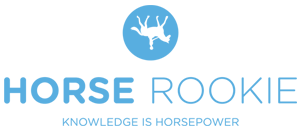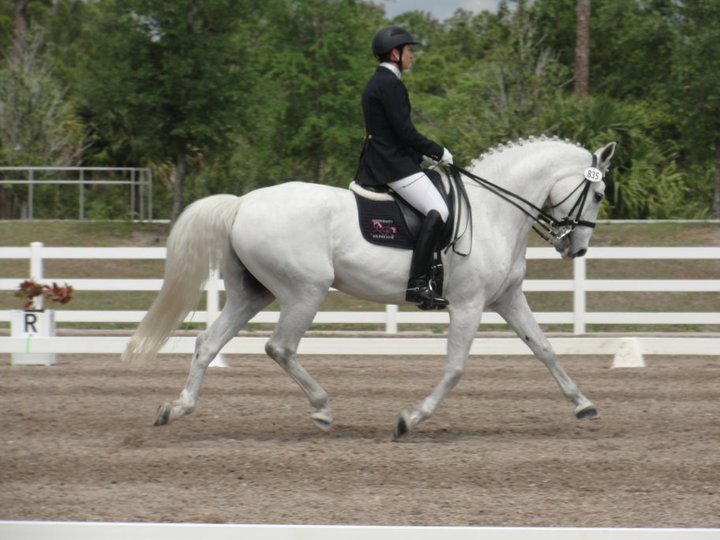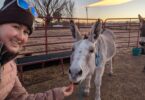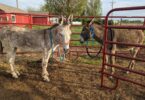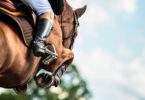How to Use the Circle of the Aids When You Practice
Welcome back to our series about the Circle of the Aids! How did you do with your riding assessment from Part One? Did you find out you weren’t asking your horse things quite as clearly as you thought. Or, did you proudly realize you were actually pretty clear but your horse doesn’t respond? Riding and training is a journey, not a destination. Even the best riders go into a
Now that you have a basic understanding of the aids, what do you do with them? As always, approach one thing at a time. Just like you have a checklist for hooking up your horse trailer, you should have a checklist for each training session on your horse. When you begin your ride with a series of check-ins, you will have a much clearer idea of what you and your horse need to be successful for that day’s ride.
Start With the End in Mind
I’m going to jump ahead to where we want to end up – what are we really looking for? It’s a concept called “Throughness.” This is also known as “on the bit,” “round,” “to the hand,” and “over the back.”
For most riders, Throughness is the hardest part of riding – yet it is the foundation of anything you do on your horse.
While we all know that we want Throughness, it is often hard to achieve. It can feel particularly elusive to maintain when we multitask, like doing a movement or a test. Using the Circle of the Aids in a constant assess-and-assign manner helps create and maintain Throughness…but how?
New to the sport? Check out our 27-Page Horse Rookie’s Guide to Dressage.
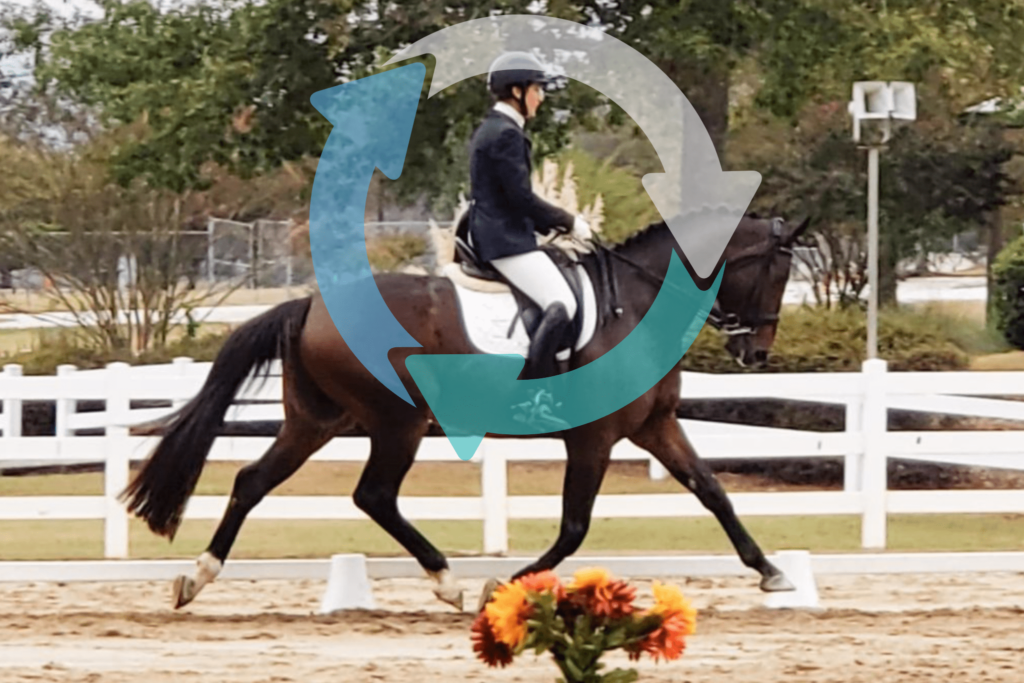
Source: Stephany Fish Crossman
Get Honest About Your Goals
Consider what you want to achieve with your horse from a
The difference between all of these is the rider: YOU are the framework that “frames” your horse. How? With the ever-increasing expertise of your quiet, steady seat and the Circle of the Aids.
Using your Leg
If you have ridden Dressage for very long, you have heard the phrase “inside leg to outside hand.” This is a very standard directive in
HOW
How do you want the horse to respond? Do you want the horse to increase their power at the current gait, or do you want them to switch into a higher gait? Do you feel them starting to sag backwards in their energy and want them to fill up your hand better, or do you want them to move sideways?
Your intent is a valuable part of the use of your leg, and that comes from your brain.
WHAT
What kind of answer does your horse give? This is based a lot on what kind of horse you are riding, and we don’t mean which breed. Is your horse hot and answers too easily off the leg, or is he a little sleepy and takes a while to answer? In either case, what kind of answer your horse gives needs to be considered when revving the motor.
Ultimately, we want a sensitive but not overreactive answer from every horse, but that comes with time and thought (on your part, not theirs…they don’t think about this stuff!).
Using leg is more complicated than it looks, but you can make things work if you think through what you’re looking for. This is why we checked out our clarity of aids in the first part, to make sure we are being clear with our ask. Now is the time to become even more specific about your intent.
Once you have revved the motor, you will feel the answer in two places: under your saddle and into your hand.
Using Your Hands
While the power will pass under your seat first, we are going to talk about the use of your hand first. Reasoning for this is simply: while your seat is a vital piece of your riding gear, its first and foremost job is to learn to be still and listen. Not locked, not braced, but moving as much as the horse and no more.
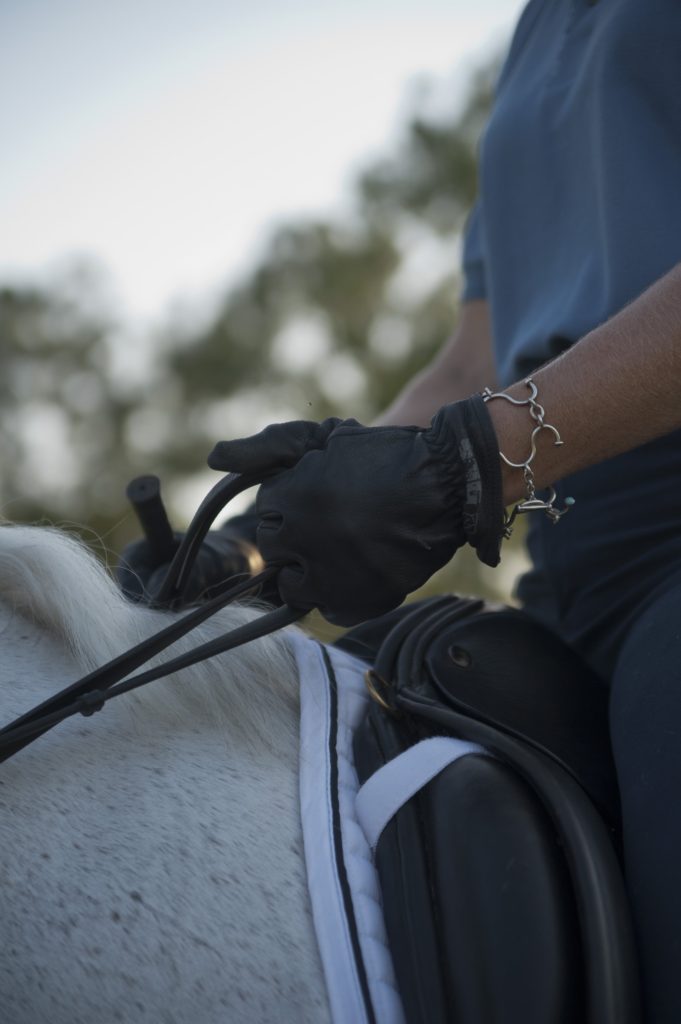
Source: Stephany Fish Crossman
The ability to stay still in motion in the saddle brings you a greater ability to hear the horse with your seat, and increases your sense of feel and timing. Once this is accomplished, your seat will become the brain of your Circle.
Your hand is the final receptacle for the energy and power your leg created (and your seat modified).
The horse should always be traveling to your hand, and this is a very important concept. If the rein is too short or the hand is pulling, the energy of the hind leg gets trapped and shut down, and cannot recycle. If the rein is too long and the horse cannot reach it (meaning the rein is longer than the horse’s neck at that moment in time), then the energy you created will run out the front end of the horse and will get lost. Either way you will feel like the horse is losing power and feel the need to kick.
Because of the imbalance of the Circle of the Aids, the horse may not be able to answer you in a balanced manner, which can cause all sorts of confusion for you both.
New to the sport? Check out our 27-Page Horse Rookie’s Guide to Dressage.
Off-the-horse examples:
- You ask someone (who is visiting you from out of town) to go to the store to get groceries. You give them the keys to your car, which is full of fuel, but you don’t tell them where the store is, or what groceries they’re going to need. They will be reluctant to leave the driveway, as they don’t know where they’re going, or how to get there. They might try to figure it out, but they would drive much slower than normal, and maybe make extra mistakes getting there. This is an example of the rein being too long to receive and recycle.
- You ask someone (who is visiting you from out of town) to go to the store to get groceries. You give them the keys to your car, which is still full of fuel, but there are cars parked behind it and they cannot get the car out of the driveway. They might try to maneuver the car out on the lawn, but that would make a big mess so they give up. This is an example of the rein being too short to receive and recycle.
You can see how important being “just right” is in your rein length to helping the horse answer you – it means the difference between making a great dinner and running out of milk. These examples simply highlight the ease at which confusion can take place between you and your very well-meaning horse if we cannot balance the Circle of the Aids well.
Using Your Seat
We step finally to the middle portion of the Circle, your Seat. A gentle reminder that your seat encompasses everything from your knee up to your bum, going on up to the torso and back, and down to finish at your elbow.

Source: Stephany Fish Crossman
We have already established that your seat is the conduit through which the power (generated by your lower leg) runs on its way down the neck to the hand. But what exactly does the seat do? This is the age-old magic of great riders, the secret which many may try but none can impart to you.
The seat, while being still AND in motion with the horse all at the same time, is the computer for your ride.
It is the part of you that feels the power of the hind leg and tells the rest of you what to do. It is the part that feels the hand being pulled on and gets the rest of the body started on fixing that problem. It is the conduit for your intent to connect with the horse and let them know you really mean it when you ask for something. These are all things that come to riders in different degrees, according to the amount of riding they do, the amount of attention they pay, and the amount of correction they receive from their coaches.
Do not despair if you do not yet have a “great” seat – great seats are developed, and very few are born. There are absolutely people born with a great “feel” in their seat, but I promise you they have worked hard (whether they know it or not) to improve it.
How to improve your seat:
- In the walk, work to feel that each of your seat bones (you have 2) are equal in weight and distance from the horse’s spine at all times (meaning during straight lines, on circles and through changes of direction)
- In the walk, work to discover the trajectory of each seatbone – does one move like a semi-circle, while one moves like a capital i? Try to make each of them move like an I, and be as matching as possible.
- In the walk, work to make sure that the I shaped movement of your seat bones is small – not stuck, but how small could it be? If your seat bones moving smaller makes the horse slow down, ADD LEG, not more seat. (The Circle of the Aids is whispering your name!!)
- With all of the above going well, try to find the movement of each of the horse’s feet under your seat bones, one at a time. Remember that whoever controls the speed of the seat bones controls the horse’s feet!
- Now, do this at the trot. Work your way through it slowly, at posting trot first, and be patient with you and your horse. You are following a path that you haven’t travelled before, and he is waiting for signals to get clear as to where to go.
Parting Thoughts
As you start to dive into the mechanics of what your seat can and should not do, you will start to feel the need to add leg, to keep the horse going, or add hand, to keep him from running out the front. This, finally, is the Circle of the Aids in motion – congratulations!
Keep playing with this concept as you move forward in your work, and whenever you hit a stumped point, go back and see where the Circle might have gotten stuck. It’s a journey, for sure, but a well worthwhile one, for you and your horse.
P.S. Enjoy this article? Trot on over to:
- Dressage Circle of the Aids: A Simple Explanation
- 8 Best
Dressage Saddle Pads For Letter-Perfect Tests - 7 Ways to Wow Judges & Improve Your
Dressage Scores - What Are the Levels of
Dressage ? - 3 Best
Dressage Boots for the Perfect Leg Position - 3 Best
Dressage Boots for Horses Moving Up the Levels - 4 Dressage Fashion Trends & Salute-Worthy Styles
- Matt Harnacke
Dressage Equestrian Vlog
